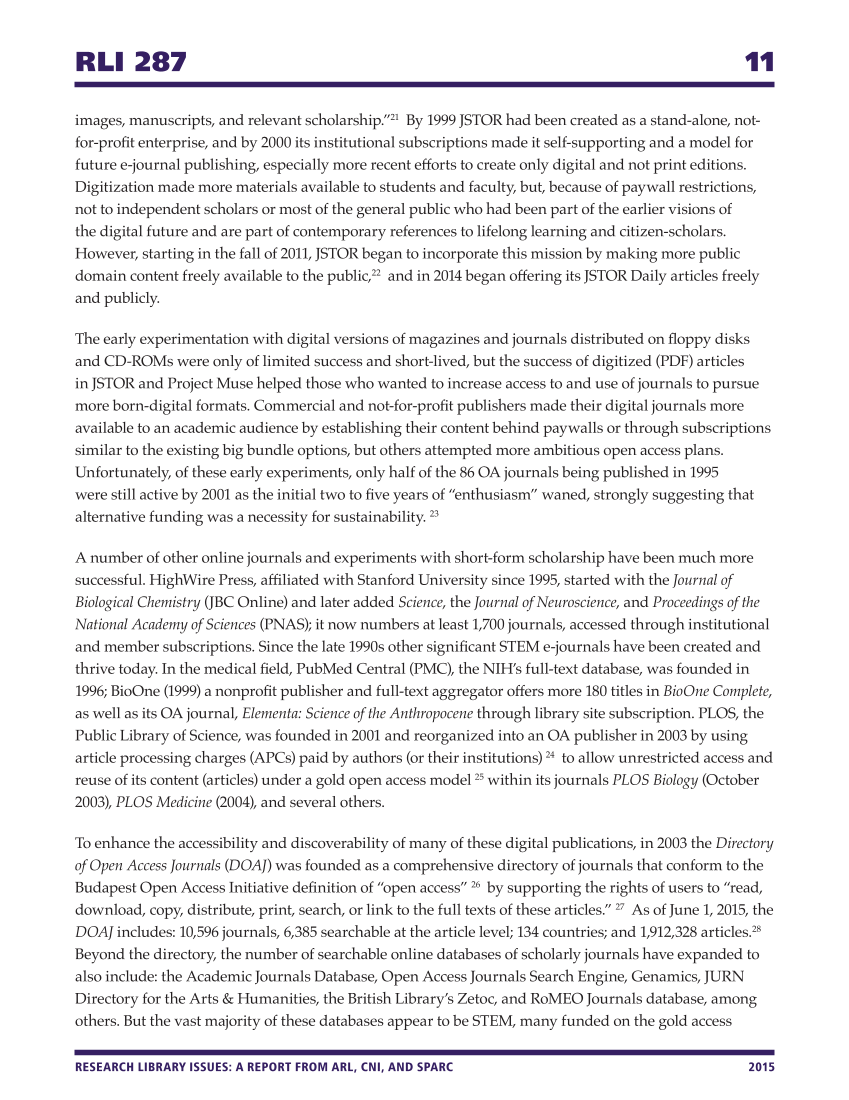RLI 287 11 RESEARCH LIBRARY ISSUES: A REPORT FROM ARL, CNI, AND SPARC 2015 images, manuscripts, and relevant scholarship.”21 By 1999 JSTOR had been created as a stand-alone, not- for-profit enterprise, and by 2000 its institutional subscriptions made it self-supporting and a model for future e-journal publishing, especially more recent efforts to create only digital and not print editions. Digitization made more materials available to students and faculty, but, because of paywall restrictions, not to independent scholars or most of the general public who had been part of the earlier visions of the digital future and are part of contemporary references to lifelong learning and citizen-scholars. However, starting in the fall of 2011, JSTOR began to incorporate this mission by making more public domain content freely available to the public,22 and in 2014 began offering its JSTOR Daily articles freely and publicly. The early experimentation with digital versions of magazines and journals distributed on floppy disks and CD-ROMs were only of limited success and short-lived, but the success of digitized (PDF) articles in JSTOR and Project Muse helped those who wanted to increase access to and use of journals to pursue more born-digital formats. Commercial and not-for-profit publishers made their digital journals more available to an academic audience by establishing their content behind paywalls or through subscriptions similar to the existing big bundle options, but others attempted more ambitious open access plans. Unfortunately, of these early experiments, only half of the 86 OA journals being published in 1995 were still active by 2001 as the initial two to five years of “enthusiasm” waned, strongly suggesting that alternative funding was a necessity for sustainability. 23 A number of other online journals and experiments with short-form scholarship have been much more successful. HighWire Press, affiliated with Stanford University since 1995, started with the Journal of Biological Chemistry (JBC Online) and later added Science, the Journal of Neuroscience, and Proceedings of the National Academy of Sciences (PNAS) it now numbers at least 1,700 journals, accessed through institutional and member subscriptions. Since the late 1990s other significant STEM e-journals have been created and thrive today. In the medical field, PubMed Central (PMC), the NIH’s full-text database, was founded in 1996 BioOne (1999) a nonprofit publisher and full-text aggregator offers more 180 titles in BioOne Complete, as well as its OA journal, Elementa: Science of the Anthropocene through library site subscription. PLOS, the Public Library of Science, was founded in 2001 and reorganized into an OA publisher in 2003 by using article processing charges (APCs) paid by authors (or their institutions) 24 to allow unrestricted access and reuse of its content (articles) under a gold open access model 25 within its journals PLOS Biology (October 2003), PLOS Medicine (2004), and several others. To enhance the accessibility and discoverability of many of these digital publications, in 2003 the Directory of Open Access Journals (DOAJ) was founded as a comprehensive directory of journals that conform to the Budapest Open Access Initiative definition of “open access” 26 by supporting the rights of users to “read, download, copy, distribute, print, search, or link to the full texts of these articles.” 27 As of June 1, 2015, the DOAJ includes: 10,596 journals, 6,385 searchable at the article level 134 countries and 1,912,328 articles.28 Beyond the directory, the number of searchable online databases of scholarly journals have expanded to also include: the Academic Journals Database, Open Access Journals Search Engine, Genamics, JURN Directory for the Arts & Humanities, the British Library’s Zetoc, and RoMEO Journals database, among others. But the vast majority of these databases appear to be STEM, many funded on the gold access


























